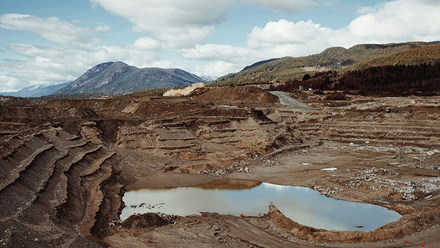Fuel for thought - exploring energy security
A recent UK Westminster forum highlighted the importance of reducing energy demand, improving its use and a holistic strategy to diversify energy sources. Nick Warburton reports.

The UK is in the middle of three interrelated crises – a rise in the cost of living, soaring energy prices, and the growing frequency and severity of climatic events. That was the sobering message delivered by Dr Marie Claire Brisbois, Senior Lecturer in Energy Policy at the University of Sussex, UK.
Opening the Westminster Energy, Environment & Transport Forum policy conference on priorities for UK energy security on 14 October, Brisbois urged the then Liz Truss-led administration to revisit the Energy Security Strategy that the government had published in April. She called for a new energy policy that 'better meets the needs of the people living in this country'.
She argued that reducing energy demand was one of the fastest and most effective ways to respond to the UK’s challenges. The UK Government could assist, she proposed, by designing better schemes to support people in retrofitting their properties so they were more energy efficient.
Jade Lewis, Chief Executive of the Sustainable Energy Association, was one of a number of speakers who echoed the twin call for reducing energy demand and a greater emphasis on energy efficiency.
She pointed to data from National Energy Action, which suggests the April price cap on rising energy costs has resulted in almost a quarter of all UK households being classified as fuel poor. She called on industry to develop solutions for improving the fabric of buildings and installing low-carbon heating systems at scale.
Lewis outlined how the Sustainable Energy Association advocates for a national retrofit strategy to provide industry with the certainty it needs to 'retrofit the millions of homes in fuel poverty in the most cost-effective way'. Leaving people in poor living conditions, she added, would cost the taxpayer an estimated £18bln a year.
Amie Jones, Senior Policy Adviser at the Confederation of British Industry (CBI), meanwhile, highlighted the impact of the current energy crisis on the more than 190,000 businesses the CBI represents across the UK economy.
She warned that some businesses have seen their energy costs soar as much as five times. To add to the considerable pressure, an increasing number of hedges are coming to an end, leaving many exposed to spot prices and higher contract prices. Although this varies across the economy, Jones said businesses in energy-intensive sectors are being hardest hit.
Confidence has been dampened, she added, which is problematic as businesses are critical in delivering the investment needed in energy-efficiency measures and enhancing the UK’s energy security.
Making waves for renewables
On the issue of developing domestic energy sources to wean the UK off its dependence on imported fossil fuels and accelerating the transition towards a low-carbon energy system, Brisbois called for a 'massive build out of wind and solar’. She argued that renewables were 'currently nine times cheaper than gas' – a ratio that would become even more favourable as gas prices rose.
She admitted, however, that the intermittent nature of renewables meant that they would not offer the same reliability that the UK was used to. This would require reform of the National Grid and modifications to energy storage, including batteries and large-scale alternatives.
In the subsequent Q&A session, Viscount Trenchard, Vice-Chair of the All-Party Parliamentary Group for Energy Security, asked the speakers about the feasibility of developing technologies that could provide energy storage for more than one or two days.
George Anstey, Managing Director, NERA Economic Consulting, pointed to the Department for Business, Energy & Industrial Strategy (BEIS)’s programme on long-duration storage. However, he warned that long-term energy storage solutions would remain expensive and therefore would probably not be the 'first port of call' when 'smoothing out the peaks from offshore wind'.
Meanwhile, Kerry Hayes, Project Development Manager at Simply Blue Energy – a floating offshore wind developer – pointed to National Grid’s latest future energy scenarios, and argued that renewables capacity would need to be ramped up by between 100 and 150GW in the next 13 years.
To ensure that renewable energy projects are given the green light in a 'timely manner', she called for reform of the planning process. At the same time, she called for significant investment in the grid infrastructure, so the 'vast quantities of renewables' could be accommodated.
Barnaby Wharton, Head of Policy at RenewableUK, concurred that the wind industry, both offshore and onshore, would play a huge role in a future electricity system and reiterated the point that more wind generation needed to be connected to the grid.
'Over the past decades, since privatisation of the energy networks, we’ve built something like 180km of new cable,' he said. 'We need to put something like 800km in over the next decade.'
He stressed that wind and other renewables also needed long-term revenue support that would return capital investments in a way that delivered 'a functioning and responsive market in the short term'.
However, Warren East, CEO at Rolls-Royce, felt that a fundamental issue had been overlooked in the discussions, namely the 'sheer quantity of energy' that is required across sectors.
Taking the energy used to power one train journey from London to Derby, he warned that a single wind turbine would require a year to generate enough energy for three train journeys of similar length.
This prompted the session chair, Trenchard, to suggest that a 'higher proportion of baseload energy' might be needed and questioned a system that relied 'almost entirely on renewables'.
He proposed that some small modular reactors (SMRs) and advanced modular reactors (AMRs) for nuclear energy could be rolled out and commercialised quickly. As an added benefit, their small size and flexibility means they could be sited outside industrial clusters to generate electricity and industrial heat.
Trenchard argued nuclear was more reliable than either solar or wind, and does not suffer from intermittency problems. However, Brisbois told the conference that nuclear posed some energy security concerns, pointing to the fact that during periods of extreme heat, France has had to shut down some of its nuclear fleet because it needed water for cooling.
Strategic innovation
Strategic innovationManu Ravishankar of Innovate UK highlighted the priorities of the Strategic Innovation Fund – a partnership programme with the UK energy regulator OFGEM.
Launched in 2021, the Fund is expected to invest around £450mln by 2026. Innovation priorities for energy security include:
- Support for large-scale thermal storage to encourage decarbonisation at lower cost, reduce peak demand and better match supply and demand.
- Support to reduce renewable energy curtailment where there are network issues, for example, through coupling to other sectors to improve system efficiency, and also creating alternate, low-carbon fuels like hydrogen to help decarbonise hard-to-abate sectors.
- Support for projects that use renewable energy generators to help diversify the source of stability services, for example, integrating offshore wind farms with storage supercapacitors to reduce overall system costs and reduce the number of fossil fuel generators needed.
- Support for offshore direct current (DC) networks with the intention of moving beyond single-point connections to multipoint or meshed grids, including focusing on DC circuit breakers so that faults can be isolated.
- Supporting hydrogen transition in a cost-effective and secure way, for example, through a blended hydrogen network, which would enable different levels of purity and blends to be used. Also, enabling the retrofit of existing compression technologies and exploring coatings on existing gas networks.
- Overseeing the secure running of a net-zero power system and managing its stability when a large number of renewables are connected to the network.
- Unlocking flexibility from heat networks to demonstrate their potential in meeting a peak load, particularly in a future high-electrified scenario.
- Testing the structural resilience and robustness of an energy system to see how quickly it can resume essential services after a particular interruption, notably in light of the increasing coupling of sectors.
- Exploring how to leverage demand reduction as a tool to support more cost-effective decarbonisation and unlock network capacity.
Getting the right energy mix
Guy Buckenham, Head of Strategic and Emerging Markets Policy at EDF Energy, concluded that a future energy system would need a mix of both renewables and nuclear.
He added that it was unclear how much each of the different energy sources could contribute and at what cost. However,
he said that 'the proportion of nuclear in the mix' would help to bring the overall system cost down.
'If we’re going to deliver a secure, affordable and low-carbon system, we need the right policy mix,' he continued. 'And the real challenge for policy is delivering on many timescales all at once.'
Neil McDermott, Chief Executive at the Low Carbon Contracts Company, concurred that a diverse, low-carbon energy mix was critical to energy security. He added that from a Contract for Difference (CFD) Portfolio perspective, it was interesting to note that the Low Carbon Contracts Company had offshore wind, onshore wind, new nuclear, remote island wind, but also other new technologies such as floating offshore wind and tidal, in its contracts.
'The important point here, from a security perspective, is that these low-carbon technologies are strategically independent for the UK,' he asserted.
McDermott added that private sector investment was critical, and also emphasised the importance of a mechanism to provide energy capacity during periods of stress and when there may be a risk of insufficient capacity, as this would also provide short-term security.
Hydrogen’s role
The role of hydrogen in supplying energy for industrial processes also added another dimension to the discussions.
Anstey explained that reducing the commodity cost materially through very cheap generation of hydrogen would lead to a reduction in the levelised cost. This would make hydrogen a more attractive option – the main challenge, he added, was coordinating action.
Jones concurred, adding that more clarity was needed from government on other sectors, besides heavy industry, where hydrogen could offer a solution for decarbonisation. Heat was one, but other applications like transport also required consideration.
'We know electrification isn’t going to be appropriate for certain modes of transport like heavy goods vehicles,' she said. 'So, we need government to give a bit more direction to those sectors that hydrogen is the route for them. Without that direction, there is a reluctance to invest and innovate – to make those solutions viable.'
Buckenham said that he would like to see large-scale use of electrolysis to produce hydrogen. 'It will be a relatively expensive fuel, but still could be quite a useful one, providing some of the peaking power needed in the power system, which is part of how we displace some unabated gas,' he said.
Chris Manson-Whitton, Director at Progressive Energy, pointed to hydrogen’s benefits in terms of latency and storage.
Progressive Energy focuses on hydrogen and carbon capture and storage, he explained, and the business has 1.3TWh of hydrogen storage in its high-net infrastructure – equivalent to the batteries contained in 25 million vehicles.
'Let’s put that into context,' he said. 'The newest pump storage facility in Europe was opened in July [and] that has 20GWh of storage.'
Beside heavy industries, he added that dispatchable power plants could also take hydrogen from the high-net system.
Security and market reform
Closing the conference, Robert Hewitt, Deputy Director, Electricity Security & Market Reform at BEIS, outlined the policy priorities for UK electricity security and electricity market reform.
Asked how important the government considered its role in advancing energy efficiency as part of managing demand, he indicated the administration might move beyond relying on price signals and focus increasingly on the demand side over the next 18 months.
Insulation to reduce gas imports
New analysis from the UK Energy and Climate Intelligence Unit (ECIU) emphasises the twin role that loft and wall insulation can play in reducing energy demand and improving the nation’s energy supply.
The non-profit organisation argues that up to 384TWh of gas could be saved between 2030-2035 if a large proportion of the UK’s homes are brought up to a basic level of insulation this decade. It compares this saving with the 118TWh of gas that could be produced by new North Sea drilling over the same period.
The ECIU adds that 384TWh is equivalent to a fifth of the UK’s current total annual household gas demand, or 11% of gas imports.
It estimates that only 150,000 homes will have benefitted from energy efficiency installations during 2022. If that rate continues for the rest of the decade, the ECIU suggests that around 1.2 million UK homes will have been insulated by the close
of 2030. This figure, it argues, falls far short of the number required to reach the government’s target of ensuring most homes achieve Energy Performance Certificate band C rating by 2035.







